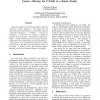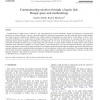6 search results - page 1 / 2 » Factors Affecting the Z-Width of a Haptic Display |
ICRA
1994
IEEE
13 years 8 months ago
1994
IEEE
This paper addresses the performance of force-reflecting interfaces ("haptic displays"). We suggest that an important measure of performance is the dynamic range of achi...
HAPTICS
2006
IEEE
13 years 10 months ago
2006
IEEE
When designing a vibrotactile information display, it is important to present correct, stable stimulation. However, the mechanical stability of the vibration is affected by many c...
HAPTICS
2006
IEEE
13 years 10 months ago
2006
IEEE
Vibrotactile displays are expected to be useful and effective tools for presenting personal information. However, various external factors, such as the orientation of the tactor o...
CHI
2007
ACM
14 years 5 months ago
2007
ACM
Physical controls such as knobs, sliders, and buttons are experiencing a revival as many computing systems progress from personal computing architectures towards ubiquitous comput...
IJMMS
2007
13 years 4 months ago
2007
Communication of affect across a distance is not well supported by current technology, despite its importance to interpersonal interaction in modern lifestyles. Touch is a powerfu...


